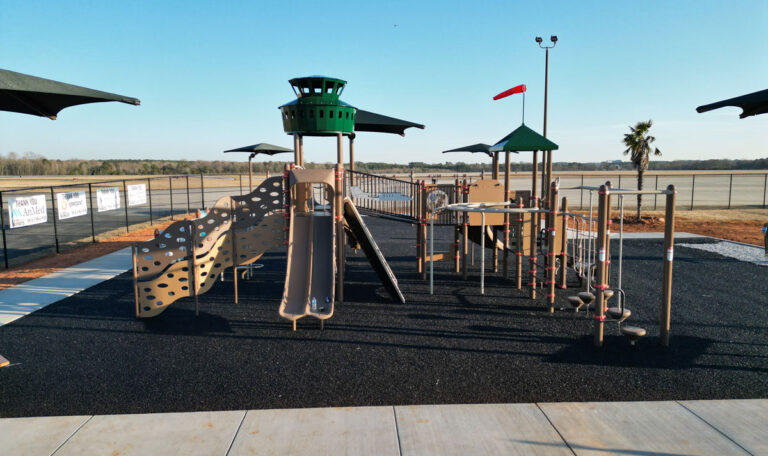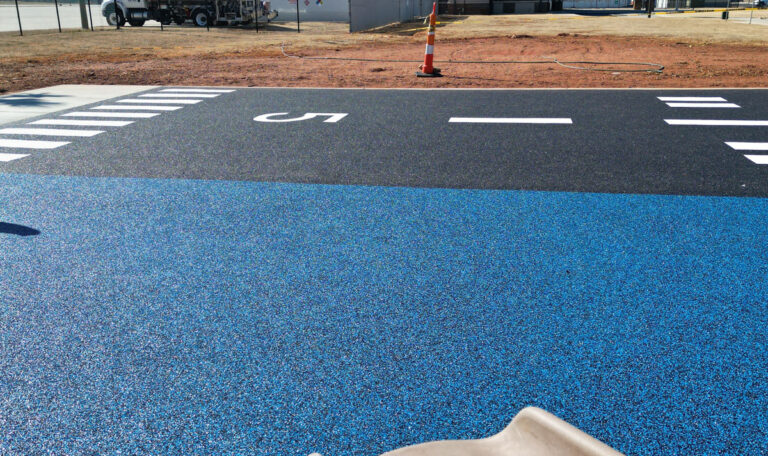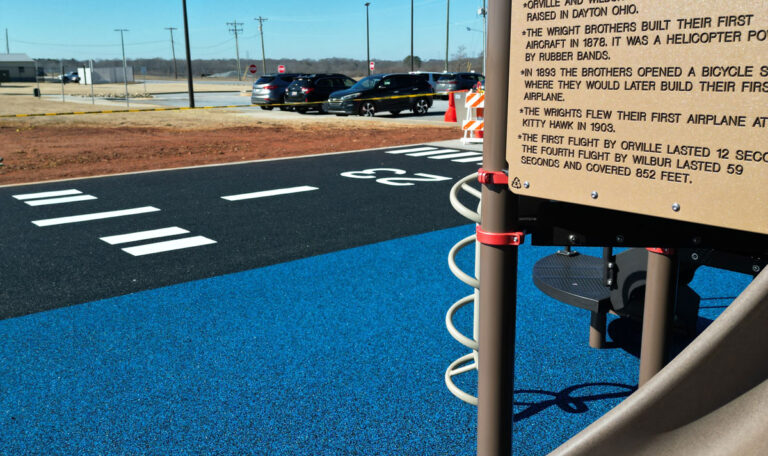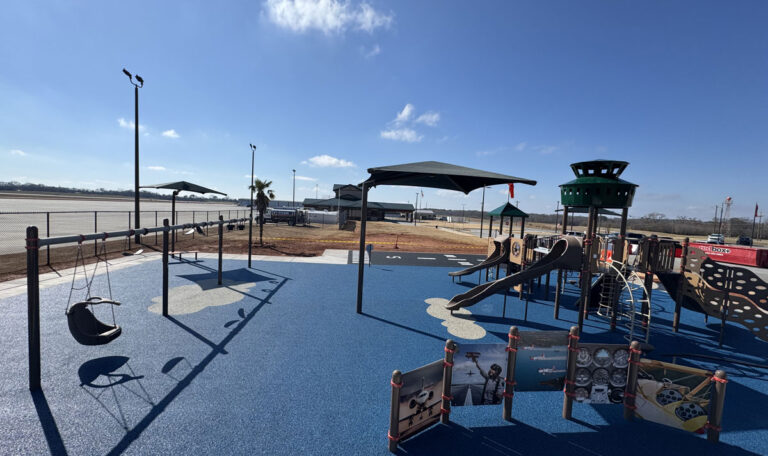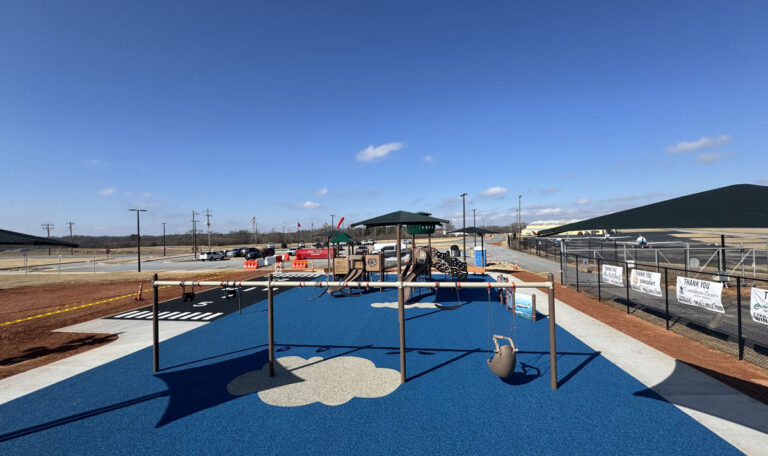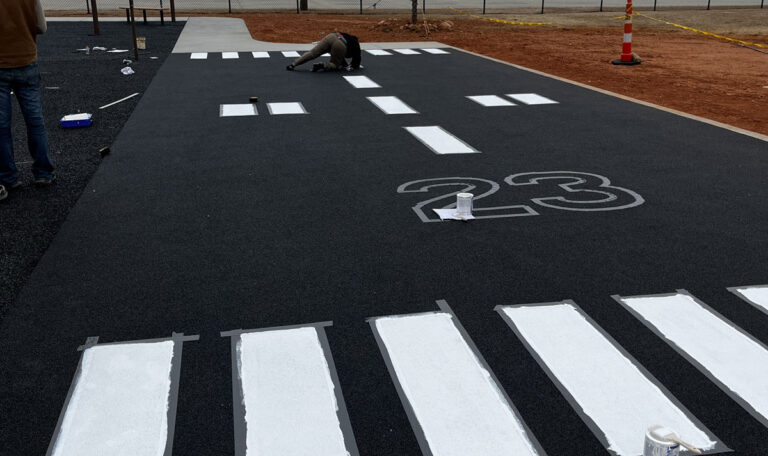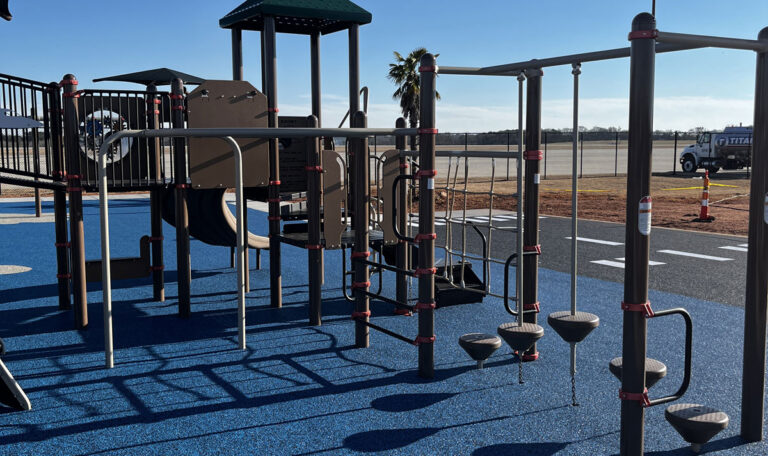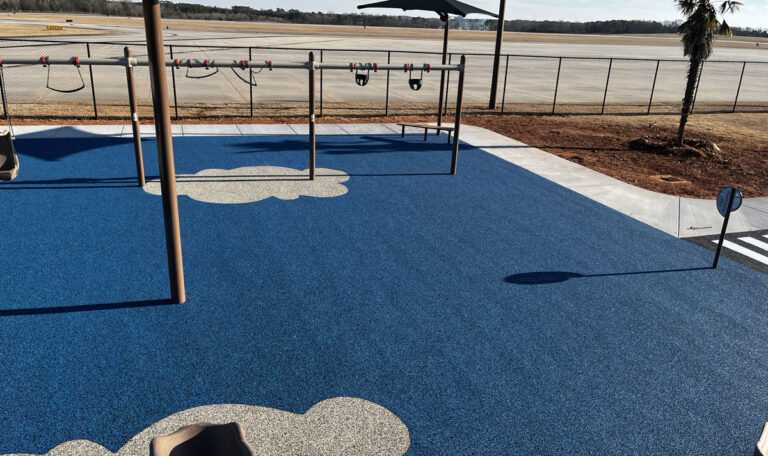Wetpour rubber surfacing is revolutionizing playground safety with its impact-absorbing, seamless design made from recycled rubber granules. This eco-friendly surface is not only durable and low-maintenance, but it also improves playground aesthetics with customizable colors and patterns. If you’re looking to upgrade your facility, here’s why wetpour rubber surfacing might be the ideal choice:
- Safety: Absorbs impacts, reducing injury risks.
- Durability: Withstands heavy foot traffic and extreme weather.
- Low Maintenance: Requires minimal upkeep compared to traditional materials.
- Customizable: Offers a variety of colors and designs.
I’m Landon Olson, and with my background in sustainable rubber surfacing solutions, I’ve dedicated my career to changing environmental challenges into innovative playground materials. Let’s explore how wetpour rubber surfacing can be both safe and sustainable.

Wetpour rubber surfacing terms you need:
– installing playground tiles
– rubber softfall cost
– soft fall rubber mats
What is Wetpour Rubber Surfacing?
Wetpour rubber surfacing is a modern solution for safe and durable playgrounds. It combines rubber granules and polyurethane resin to create a seamless, impact-absorbing surface.
Rubber Granules
The core component of wetpour surfacing is rubber granules. These are usually made from Ethylene Propylene Diene Monomer (EPDM), a type of synthetic rubber known for its durability and resistance to UV rays and extreme weather. The granules are small, ranging from 1.0 to 4.0 mm, which allows for a smooth and even finish. EPDM granules are particularly valued for their high resistance to water and common chemicals, making them ideal for outdoor use.
Polyurethane Resin
The rubber granules are bound together using a polyurethane resin. This is a moisture-cured binder that ensures the surface remains intact and durable over time. The resin is based on high-quality diphenylmethane diisocyanate (MDI) prepolymer, which provides excellent adhesion and flexibility. This combination ensures that the surfacing can withstand heavy use and harsh weather conditions without cracking or peeling.
Seamless Surface
One of the standout features of wetpour rubber surfacing is its seamless design. Unlike tiles or other materials that require joints or seams, wetpour surfacing is poured directly onto the prepared base, creating a smooth, continuous layer. This seamless quality not only improves the visual appeal but also reduces tripping hazards, making it safer for children to play on. Additionally, the absence of seams prevents dirt and debris from accumulating, making the surface easier to clean and maintain.

Wetpour rubber surfacing is an excellent choice for playgrounds, sports facilities, and more due to its combination of safety, durability, and aesthetic flexibility. Whether you’re looking to create a vibrant play area or a muted, professional-looking sports court, this material offers endless possibilities.

Benefits of Wetpour Rubber Surfacing
Wetpour rubber surfacing offers several key benefits that make it an ideal choice for playgrounds and other areas where safety and durability are paramount.
Impact Absorption
One of the most significant advantages of wetpour rubber surfacing is its excellent impact absorption. This surface is designed to cushion falls, reducing the risk of injury. According to experts at Replay Surfacing, the material’s shock-absorbent properties make it perfect for areas where children play and run. By providing a forgiving surface, it ensures that accidents are less likely to result in serious injuries.
Durability
Durability is another standout feature of wetpour rubber surfacing. The combination of rubber granules and polyurethane resin creates a tough, long-lasting surface that can withstand heavy use and harsh weather conditions. This resilience means that, with proper maintenance, wetpour surfaces can last for over a decade without significant wear or damage. The material’s resistance to cracking, fading, and peeling ensures that it remains safe and visually appealing over time.
Low Maintenance
Maintaining wetpour rubber surfacing is straightforward and cost-effective. The seamless design prevents dirt and debris from accumulating in cracks or seams, making it easy to clean. Regular cleaning with water and mild detergents is usually sufficient to keep the surface in top condition. Additionally, its non-toxic and microbial-resistant properties contribute to a hygienic play environment, reducing the need for frequent deep cleaning.
Customizable Colors
Wetpour rubber surfacing is highly customizable, offering a wide range of colors and patterns to suit any aesthetic preference. Whether you want a vibrant, playful playground or a more subdued, neat look, wetpour surfacing can be custom to meet your design needs. This versatility in design allows for creative and thematic spaces that improve the overall atmosphere of the area.
In summary, wetpour rubber surfacing not only provides a safe and durable solution for high-traffic areas but also offers flexibility in design and ease of maintenance. These benefits make it a preferred choice for playgrounds, sports facilities, and other public spaces.
Next, let’s explore the cost considerations for wetpour rubber surfacing, including factors affecting the price and installation costs.
Cost Considerations for Wetpour Rubber Surfacing
When planning for wetpour rubber surfacing, understanding the costs involved is crucial. This section breaks down the cost per square foot, factors that influence the price, and the installation costs.
Cost Per Square Foot
For larger playground areas (1,000 sq. ft. or more), the cost of wetpour rubber surfacing typically ranges from $9 to $18 per square foot. This price range includes the installation and materials. Smaller projects may see higher costs per square foot due to the minimum materials required.
Factors Affecting Price
Several factors can influence the overall cost of your wetpour rubber surface:
- Fall Height Requirements: The thickness of the surfacing needed to safely cushion falls can affect the cost. Higher fall height requirements mean more material is needed, which increases the price.
- Color Choices: While there is a wide variety of colors available, opting for custom or multiple colors can raise costs. Standard colors are generally more economical.
- Existing Surface Condition: If the area requires significant preparation, such as leveling or repairing the base, the costs will be higher.
- Location: Costs can vary by location due to differences in labor rates and material availability. For example, installation in more remote areas might incur additional transportation costs.
Installation Costs
Professional installation is recommended for wetpour rubber surfacing to ensure safety and longevity. The process includes site preparation, laying the rubber surface, and allowing time for curing.
- Site Preparation: This involves clearing and leveling the area, which can vary in cost depending on the site’s condition. Proper drainage must also be considered to prevent water accumulation.
- Curing Time: After installation, the surface needs at least 24 hours to cure, especially in cooler weather. This ensures the polyurethane resin binds the rubber granules effectively.
In conclusion, while the initial investment in wetpour rubber surfacing might seem significant, the long-term benefits of safety, durability, and low maintenance make it a cost-effective choice for playgrounds and other high-traffic areas.
Now, let’s move on to the installation process of wetpour rubber surfacing, where we’ll discuss site preparation, curing time, and professional installation.
Installation Process of Wetpour Rubber Surfacing
Installing wetpour rubber surfacing is a step-by-step process that ensures a safe and durable play area. Let’s break down what happens during installation, from preparing the site to the final curing stage.
Site Preparation
Before any rubber is laid down, the area needs to be prepared. This is one of the most crucial steps to ensure a smooth and long-lasting surface.
- Clearing and Leveling: The ground must be cleared of debris and leveled. This might involve removing old surfaces or filling in dips and holes to create a flat base.
- Drainage Consideration: Proper drainage is vital. Water should not pool on the surface, so the ground might need slight grading or the addition of drainage features.
- Edge Installation: Pre-cast concrete or rubber edges are recommended. These edges help keep the surface intact as weather changes cause the rubber to expand or contract.
Professional Installation
Once the site is ready, the actual installation of the wetpour rubber surfacing begins. This is where professional expertise ensures the best results.
- Mixing and Laying: The rubber granules are mixed with a polyurethane resin. This mixture is then spread evenly over the prepared area, creating a seamless surface.
- Layering for Safety: If the surface is under playground equipment, the thickness might be adjusted to meet Critical Fall Height (CFH) requirements, providing extra cushioning where needed.
Curing Time
After the surface is laid, it needs time to set properly.
- Curing Period: The curing process usually takes at least 24 hours. It’s crucial to allow this time for the surface to harden and bond fully. In colder temperatures, curing might take a bit longer.
- Post-Installation Check: Once cured, a quality check ensures there are no imperfections and the surface meets safety standards.
This structured approach guarantees that wetpour rubber surfacing is not only safe and durable but also visually appealing. Next, we’ll tackle some frequently asked questions to clear up any other concerns you might have about this versatile surfacing option.
Frequently Asked Questions about Wetpour Rubber Surfacing
How long does wetpour rubber last?
Durability and Lifespan
Wetpour rubber surfacing is designed to be a long-lasting solution for playgrounds and other areas. Generally, it can last anywhere from 10 to 15 years, depending on several factors such as usage, maintenance, and environmental conditions.
- High Traffic Areas: Surfaces in high-use areas might wear faster, but regular maintenance can extend their lifespan.
- Weather Resistance: Wetpour is resistant to UV rays and extreme temperatures, making it durable even in harsh weather.
Maintenance
Keeping your wetpour surface in top condition is simple. Regular inspections and occasional cleaning with water and mild soap are typically enough. This low maintenance requirement helps keep the surface looking new for years.
How much does wetpour rubber cost?
Pricing and Cost Range
The cost of wetpour rubber surfacing can vary based on several factors:
- Size of the Area: Larger installations tend to have a lower cost per square foot, ranging from $9 to $18.
- Thickness and Safety Requirements: Areas requiring more impact absorption will need thicker layers, which can increase costs.
- Design Complexity: Custom designs or multiple colors might add to the overall price.
Factors Affecting Price
- Site Preparation: Costs can increase if significant groundwork is needed before installation.
- Location: Accessibility and local labor rates can also impact the price.
How long does wetpour rubber take to dry?
Curing Time and Weather Dependency
After installation, wetpour rubber needs time to cure before it is safe to use. Typically, this process takes about 24 hours.
- Temperature and Humidity: In colder or more humid conditions, the curing time may extend beyond 24 hours. It’s essential to plan for this if you’re installing in winter or rainy seasons.
- Safety First: Ensure the surface is fully cured before allowing use to maintain safety standards and surface integrity.
Understanding these aspects of wetpour rubber surfacing can help you make informed decisions for your next playground project. Whether considering costs, longevity, or installation timelines, having these insights ensures you get the best value and performance from your investment.
Conclusion
At Replay Surfacing Inc., we believe in creating spaces that are not only safe and functional but also sustainable. Our wetpour rubber surfacing is a testament to this commitment. By recycling tires into durable playground surfaces, we transform what was once an environmental hazard into a valuable, eco-friendly product.
Sustainable Surfaces
Our products are crafted from recycled rubber, offering a sustainable solution for playgrounds, sport courts, and splash pads. This not only helps reduce waste but also contributes to a cleaner environment, aligning with our vision of environmental sustainability.
Recycled Materials
Using recycled materials doesn’t mean compromising on quality. Our surfaces provide excellent impact absorption, are slip-resistant, and maintain their vibrant colors over time. Plus, they are ADA compliant, ensuring accessibility for everyone.
Choosing Replay Surfacing Inc. means investing in a product that cares for both people and the planet. Our surfaces are designed to last, offering long-term savings and peace of mind.
For more information on how our rubber surfacing can benefit your playground project, visit our Playgrounds Service Page.
Together, let’s make your space unstoppable!



